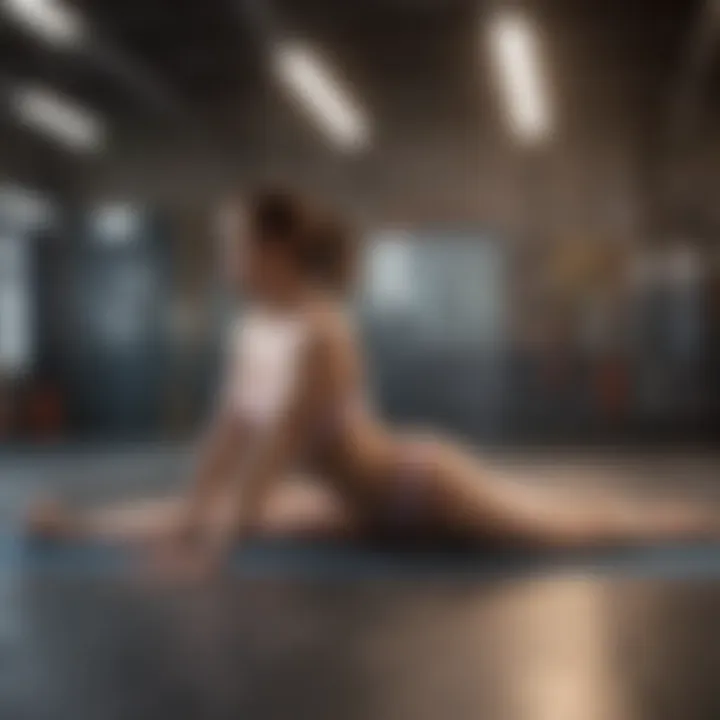Effective Exercises to Relieve Stiff Back and Hips


Intro
Stiffness in the back and hips is a common challenge faced by many individuals. This discomfort can stem from various factors, including sedentary lifestyles, overexertion, or simply the passage of time. Addressing stiffness is vital for improving mobility and quality of life. Engaging in the right exercises can greatly enhance flexibility and relieve discomfort in these areas. Understanding the key benefits and practical applications of these exercises is essential for anyone looking to effectively manage their physical health.
Key Benefits
Physical Health Benefits
Engaging in exercises aimed at alleviating stiffness provides numerous physical health benefits. The primary benefit is increased flexibility, which allows the body to move more freely and efficiently. Regular practice can lead to improved posture, reducing strain on the back and hips.
Strengthening muscles around these joints helps to stabilize them, thus decreasing the risk of injury. Furthermore, these exercises promote blood circulation, facilitating better nutrient delivery and waste removal from tissues.
- Improved Range of Motion: Allows for more extensive movements in daily activities.
- Pain Relief: Regular movement can decrease muscle tension and discomfort.
- Enhanced Strength: Strengthening can protect joints from future strains.
Mental Well-being Enhancements
The mental benefits of exercise, particularly those focused on flexibility and mobility, should not be overlooked. Engaging in these activities can lead to stress reduction and improved mood.
Exercise releases endorphins, which are known to enhance feelings of happiness and well-being. Furthermore, the focused nature of many stretching exercises can serve as a form of mindfulness, helping individuals to become more attuned to their bodies and facilitating relaxation.
"Physical activity is important for both body and mind — it offers a holistic approach to well-being."
Additionally, regular stretching and movement can improve sleep quality, contributing to better overall mental health.
Practical Tips
Effective Meal Planning
Nutrition plays a crucial role in supporting an active lifestyle. A balanced diet full of anti-inflammatory foods can further enhance the effects of exercises aimed at relieving stiffness. Consider the following:
- Include Omega-3 Fatty Acids: Found in fish like salmon, flaxseed, and walnuts, these can help reduce inflammation.
- Prioritize Fruits and Vegetables: Their rich antioxidant content aids recovery and overall health.
- Hydration is Key: Staying well-hydrated can improve joint health and recovery.
Quick and Efficient Workouts
Incorporate the following exercises for an effective routine aimed at relieving stiffness in the back and hips. These can be done in short bursts throughout the day:
- Cat-Cow Stretch: This yoga move warms up the spine and increases mobility.
- Hip Flexor Stretch: Targets tight muscles in the hips, offering significant relief.
- Seated Forward Bend: Enhances flexibility in the back and hamstrings.
By integrating these exercises and dietary practices into daily routines, individuals can greatly improve their quality of life.
Intro to Stiffness in the Back and Hips
Stiffness in the back and hips can severely influence one’s quality of life. It hinders movement and can lead to discomfort in daily tasks. This article delves into effective exercises designed to alleviate these musculoskeletal constraints. Addressing stiffness is not merely about comfort; it is a vital aspect of physical health and overall well-being.
Engaging in the right exercises can help restore mobility, enhance flexibility, and prevent further complications. Understanding the underlying causes of stiffness, and how to manage them, is paramount. This narrative aims to highlight practical solutions for readers, focusing on styles of stretches and strengthening techniques that can be integrated seamlessly into any routine.
Understanding Stiffness and Its Impact
Stiffness often manifests when muscles, joints, or connective tissues lose their elasticity. This can limit someone's range of motion, making activities like bending, reaching, or sitting challenging. When stiffness becomes chronic, it could lead to pain and even disability in severe cases. The impact on daily life can be significant, affecting work performance and enjoyment of recreational activities.
It is important to recognize that stiffness is not a standalone issue. It can be symptomatic of more serious conditions, such as arthritis or herniated discs. Therefore, identifying the nature of stiffness is crucial for effective management.
Common Causes of Stiffness
There are various reasons why one might experience stiffness in the back and hips. Some of these may include:
- Sedentary Lifestyle: Long hours of sitting or lack of physical activity can contribute to muscle tightness.
- Age: As the body ages, there tends to be a natural decline in muscle elasticity and joint lubrication.
- Injury: Past injuries can lead to scar tissue formation, limiting flexibility in affected areas.
- Poor Posture: Habitual faulty postures during work or leisure activities can lead to muscle imbalances.
- Medical Conditions: Conditions like arthritis, sciatica, or fibromyalgia can also lead to stiffness.
Understanding these causes is a step towards remediation. By recognizing specific triggers, individuals can adopt a more targeted approach to their exercise regimens.
The Importance of Mobility
Mobility is a crucial aspect of physical health that is often overlooked. It refers to the ability of joints to move freely through their full range of motion. Good mobility is not only about flexibility but also about strength and coordination. With a stiff back and hips, basic movements like bending, squatting, or walking can become challenging. This can lead to further complications if not addressed properly.
Benefits of Maintaining Flexibility
Flexibility is a key component of overall mobility. Maintaining flexibility in the muscles and joints can provide several vital benefits:
- Reduced Risk of Injury: Flexible muscles are less prone to strains and tears. When muscles are tight, they may not absorb shock effectively, leading to injuries during physical activities.
- Improved Posture: Good flexibility allows for better alignment of the body. This helps in reducing the stress on the spine, which can diminish back pain and stiffness.
- Enhanced Performance: Athletes and fitness enthusiasts benefit from increased range of motion. Whether it's running, cycling, or any sport, flexibility contributes to improved performance.
- Greater Functional Independence: For older adults especially, maintaining flexibility can aid in performing daily tasks, from getting out of a chair to climbing stairs.
Impact on Daily Activities
The implications of having stiff back and hips extend into every facet of daily life. When mobility is compromised, the quality of life can significantly diminish. Here are a few key impacts:
- Limited Mobility: Everyday activities such as walking or even standing can become laborious tasks. This can lead to a sedentary lifestyle, compounding health issues.
- Increased Fatigue: Struggling with basic movements can cause early exhaustion. When the body compensates for stiffness, it often uses more energy, leading to fatigue and lethargy.
- Social Isolation: Difficulty in moving can hinder participation in social events. This can lead to a sense of isolation, impacting mental health.
- Chronic Pain: Over time, stiffness can lead to pain. Reduced activity levels due to pain can create a vicious cycle that exacerbates both stiffness and discomfort.


"Maintaining mobility is essential not just for physical health but for overall well-being. Addressing stiffness can open a world of possibilities for a more active life."
Thus, understanding the importance of mobility and working towards it should be a priority for anyone seeking to improve their quality of life.
Starting Safely
Engaging in any form of exercise, especially when targeting stiffness in the back and hips, necessitates a foundation of safety. The importance of starting safely cannot be overstated. Proper precautionary measures ensure that the efforts made toward improvement do not lead to further injury or exacerbate existing conditions. Especially when dealing with areas prone to stiffness, like the back and hips, it is critical to consider the body's responses and inherent limitations. Adopting a cautious approach allows individuals to maximize the potential benefits of these exercises while minimizing risks.
Assessing Your Limitations
Before attempting any exercise regimen, it is essential to assess your own physical limitations. This self-evaluation is an integral part of a safe exercise routine. Understanding your current range of motion and level of flexibility can guide the selection of suitable exercises. Consider factors such as:
- Existing Pain or Discomfort: Take note of any areas that feel particularly tight or painful. Avoid pushing through sharp pains as this may lead to more severe injuries.
- Range of Motion: Determine how far you can move your back and hips without discomfort. This helps to identify which exercises can be safely performed.
- Previous Injuries: Be aware of any past injuries that might affect your current abilities. Exercises should be modified as necessary to accommodate these conditions.
By knowing your limitations, you can create a tailored routine that respects your body’s current capabilities. Keeping a log of your physical responses can also provide insights over time and help in tracking progress.
Consulting a Healthcare Professional
Another vital step in starting safely is consulting with a healthcare professional. Engaging a doctor, physical therapist, or certified trainer brings expertise that can be indispensable for anyone experiencing stiffness. They can assess your condition comprehensively and provide insights that are tailored specifically to you. Through professional guidance, you can gain:
- Personalized Recommendations: Insights into exercise variances that suit your unique health situation can prevent potential injuries.
- Safety Assessments: Etiquettes such as physical exams or imaging tests may be necessary to inform you about existing issues that need to be addressed.
- Program Design: Tailored exercise programs are crafted around your individual needs, which enhances effectiveness and safety.
It is often advisable to seek professional advice before initiating any fitness plan, especially if there are chronic issues or previous injuries to consider.
Consulting a healthcare professional serves to not only guide your exercise choice but also ensures that your approach to alleviating stiffness is both safe and effective.
Through a cautious approach centered on assessing personal limitations and seeking professional advice, individuals can engage in more effective and injury-free exercises that promote mobility in the back and hips.
Effective Stretches for the Back
Effective stretches for the back are essential in combating stiffness and enhancing flexibility. The back plays a crucial role in our overall mobility and supports various daily activities, from walking to sitting. Stretches can help alleviate tension, improve range of motion, and reduce discomfort that may stem from prolonged sitting or physical exertion. They also contribute to the overall alignment of the spine. Regularly incorporating back stretches into one’s routine can promote better posture and enhance overall physical well-being.
Cat-Cow Stretch
Technique Overview
The Cat-Cow stretch is a dynamic movement that alternates between two positions: the cat pose and the cow pose. It is fundamental in warming up the spine and releasing tension. The alignment of the head, spine, and pelvis during the movement is what makes this stretch effective. As you perform the cat pose, arch your back, tucking your chin to your chest. Transitioning to the cow pose involves lifting your head and tailbone while dropping your belly towards the floor. This stretch is beneficial because it encourages fluid motion and creates awareness of spinal movement.
Benefits
The Cat-Cow stretch has multiple benefits including promoting spinal flexibility. This stretch engages both the front and back of the torso, making it comprehensive in its approach. It prepares the body for more intense workouts by increasing circulation and warming muscles. Furthermore, it may help alleviate back pain through this gentle mobilization. It's a practical choice for those looking to ease into a routine or assess their mobility before more challenging exercises.
Child's Pose
Technique Overview
Child's Pose is a resting position that deeply stretches the back and hips. To perform this stretch, kneel and sit back on your heels while reaching your arms forward on the ground. The focus here is on elongating the spine while relaxing the shoulders. This position allows the lower back to release tension effectively. It can be especially beneficial after a workout as it acts as a recovery stretch. The simplicity of this pose makes it approachable for individuals at any fitness level.
Benefits
The benefits of Child's Pose include promoting relaxation and relieving physical stress. It allows for a gentle stretch that calms the nervous system. Additionally, it enhances flexibility in both the spine and hips, making it suitable for improving overall mobility. This stretch often serves as a transitional pose, allowing practitioners to pause and reflect during their routine. Its effectiveness in releasing spinal tension cannot be overstated, particularly for those with sedentary lifestyles.
Seated Forward Bend
Technique Overview
The Seated Forward Bend is an effective stretching position targeting the lower back and hamstrings. To execute this stretch, sit with legs extended and slowly bend at the hips to reach towards your toes. The emphasis here is on creating a long spine and avoiding rounding the back. This technique encourages flexibility in the lower back while also engaging the legs. It can enhance circulation to the spine as well as the adjacent muscles.
Benefits
One of the main benefits of the Seated Forward Bend is its ability to relieve tension in the lower back. It stretches the spine and hamstrings simultaneously, promoting overall flexibility. Engaging in this stretch regularly can also improve posture and alleviate discomfort from sitting for extended periods. People find it helpful in calming the mind and reducing anxiety, making it a multifaceted option for both physical and mental well-being.
Incorporating effective stretches for the back is a proactive approach to maintaining mobility and minimizing discomfort. Regular practice can lead to long-lasting improvements in flexibility and overall health.
Effective Stretches for the Hips
Effective stretches for the hips are not just a way to relieve discomfort; they are crucial for enhancing mobility and functionality in daily life. The hip joint is one of the most flexible and stable joints in the body, and regular stretching can help maintain that balance. Stiff hips can lead to complications, affecting movement patterns and overall wellness. Therefore, incorporating hip stretches not only alleviates stiffness but also improves athletic performance and reduces the risk of injuries.
Pigeon Pose
Technique Overview
Pigeon Pose is a well-known stretch that targets the hip flexors and rotators. To perform this stretch, you begin in a tabletop position on your hands and knees. You then bring one knee forward, placing it behind your wrist while extending the opposite leg straight back. This position allows for deep stretching in the hips. The key characteristic of Pigeon Pose is its ability to open the hip area while providing a slight twist in the spine. This makes it a beneficial choice for those seeking relief from tightness. However, care should be taken to align the body properly to avoid strain, especially for those newer to stretching or with existing injuries.
Benefits
The benefits of Pigeon Pose include increased flexibility in the hips and relief from lower back pain. It is effective for releasing tension accumulated from prolonged sitting or physical exertion. A unique aspect of this stretch is its role in improving the range of motion in the hips, which is paramount for athletic activities. While it is a powerful stretch, individuals must be cautious not to push too hard, especially if they are not accustomed to deep stretches.


Hip Flexor Stretch
Technique Overview
The Hip Flexor Stretch is essential for counteracting the effects of long periods spent sitting. To execute this stretch, you kneel on one knee, with the other foot flat on the floor in front, creating a 90-degree angle in both knees. Then, gently push your hips forward while keeping your back straight. This movement emphasizes the hip flexors, crucial for anyone who engages in activities that tighten these muscles, such as running or cycling. The key feature of this stretch lies in its simplicity and effectiveness as it can be easily performed almost anywhere.
Benefits
Doing the Hip Flexor Stretch regularly can improve posture and lower back health. Its ability to open the hips also contributes to better performance in various sports. Additionally, it enhances blood flow to the lower body, which is an advantage for overall circulation. However, individuals should ensure they do not compress the lower back during the stretch; maintaining alignment is critical.
Figure Four Stretch
Technique Overview
The Figure Four Stretch is a versatile hip stretch that not only targets the hips but also provides relief to the lower back. To perform it, lie on your back with your knees bent. Cross one ankle over the opposite knee, creating a figure four shape. You then gently pull the uncrossed leg towards you, deepening the stretch in the hips. This stretch is characterized by its accessibility and the fact that it can be adjusted for different levels of flexibility.
Benefits
The Figure Four Stretch is excellent for releasing tension in the glutes and promoting relaxation. It allows for a deeper stretch without strain, making it suitable for those with varying flexibility levels. Moreover, the unique feature of this stretch is how it encourages breath control, enhancing the stretching experience. While it is generally safe, being mindful of not forcing the knee joint is essential to prevent discomfort.
Strengthening Exercises for the Back
Strengthening exercises for the back play a vital role in alleviating stiffness and discomfort. A strong back supports proper posture and spinal alignment, which is essential for everyday activities. When the muscles in this area are weak, individuals may experience pain, fatigue, and increased risk of injury.
Several movements target specific back muscles, enhancing stability and resilience. These exercises may also aid in recovery from previous injuries, allowing individuals to resume normal function.
Consistent practice helps build endurance and strength in the back, promoting overall mobility. For anyone dealing with stiffness, incorporating strengthening exercises becomes key to long-term relief.
Bridges
Technique Overview
The Bridge exercise focuses on activating the glutes, hamstrings, and lower back. It is a simple but effective movement that can be performed on most surfaces, requiring no equipment. The key aspect of the technique is the lifting action of the hips while the shoulders and feet remain grounded.
To perform a Bridge:
- Lie on your back with knees bent and feet hip-width apart.
- Press your feet into the ground and lift your hips towards the ceiling.
- Hold the position for a few seconds before lowering back down.
The Bridge is popular due to its ability to strengthen multiple muscle groups at once. A unique feature is that it also stretches the hip flexors, which can help combat tightness in the front of the hips.
Benefits
The Bridge offers numerous advantages. First, it strengthens the gluteal muscles, which are essential for stability and power. A strong lower body improves posture and reduces strain on the back. Additionally, the exercise can help individuals develop better core strength, which is crucial for balance and protection against injuries.
Furthermore, the Bridge is often regarded as beginner-friendly. It can be modified by lifting only one leg or performing it with a stability ball, facilitating progress as strength improves. This adaptability makes the Bridge a versatile choice for various fitness levels.
Supermans
Technique Overview
The Superman exercise is an excellent way to work on the lower back and core strength. Its name comes from the position of lying on the stomach while lifting arms and legs off the ground simultaneously. This movement targets the entire posterior chain, which includes the back, glutes, and legs.
To perform a Superman:
- Lie face down on a mat with arms extended in front and legs straight.
- Simultaneously lift the arms and legs away from the ground, engaging the lower back.
- Hold for a moment before returning to the starting position.
This exercise is beneficial for developing endurance in the back muscles. It helps enhance overall stability and is straightforward enough for most individuals to begin practicing.
Benefits
Supermans cultivate important muscles that support the spine and pelvis. Enhanced strength in these areas contributes to better posture and overall athletic performance. Furthermore, this exercise helps improve coordination as it requires both upper and lower body movement in unison.
One consideration is that those with severe back issues should approach the Superman cautiously. Modification can include lifting alternate limbs instead of both arms and legs simultaneously. This allows a gradual increase in strength without over-exertion.
"Strengthening the back is crucial for overall health; it prevents injuries and supports daily activities."
Strengthening Exercises for the Hips
Strengthening exercises for the hips are vital for improving mobility and preventing stiffness in this area. Strong hip muscles support posture and enhance overall movement efficiency. These exercises emphasize the hip flexors, glutes, and abductors, which are crucial for daily activities such as walking, climbing stairs, and squatting. Additionally, by integrating hip-strengthening exercises into one's routine, individuals can reduce the risk of injury. Thus, maintaining hip strength contributes significantly to overall physical health and well-being.
Side Leg Raises
Technique Overview
The side leg raise is a simple exercise that targets the outer hip muscles, specifically the gluteus medius. The key characteristic of this technique is its accessibility; it can be performed on the floor or with a resistance band for added difficulty. To perform, lie on your side with legs stacked. Raise the top leg slowly while keeping it straight, then lower it back down. This exercise is beneficial for those seeking to improve hip stability.


The unique feature of the side leg raise lies in its focus on the gluteus medius. This muscle plays a major role in stabilizing the pelvis during activities such as running and walking. An advantage of this exercise is that it can be done without special equipment, making it convenient for home workouts. However, a disadvantage might be that it does not engage other muscle groups simultaneously.
Benefits
The primary benefit of side leg raises is the strengthening of hip muscles, which enhances stability and coordination. This is crucial for preventing injuries during dynamic movements. The exercise is popular because it can be incorporated easily into various fitness levels, providing a straightforward method to build strength in the hips without overly complicating the routine.
A notable advantage of increased hip strength includes improved balance and posture, which can positively affect movements throughout the day. However, it is important to note that overdoing this exercise can lead to muscle fatigue or strain, especially if proper form is not maintained.
Clamshells
Technique Overview
Clamshells target the gluteus medius and promote hip stability. The technique involves lying on one side with knees bent at a 90-degree angle while keeping feet together. Open the top knee like a clamshell while keeping the feet together, then lower the knee back down. This method is popular due to its ability to isolate the targeted muscles effectively.
The unique feature of clamshells is that they not only strengthen the hip muscles but also promote better core stability. One advantage of clamshells is that they can easily be modified by adding resistance bands, allowing for progression as strength builds. However, this can make the exercise slightly more complex for beginners.
Benefits
Clamshells provide the benefit of enhancing hip strength and stability, crucial for various activities such as running and cycling. Their targeted approach makes them an effective choice for addressing hip imbalances, which can arise from sedentary lifestyles or certain sports.
A key characteristic of clamshells is their ability to engage the gluteus medius, which prevents 'hip drop' during movements. This can significantly impact athletic performance and reduce the risk of injuries. However, it is important to ensure proper technique; otherwise, individuals might not get the full benefits of the exercise.
Integrating Mobility Work into Daily Routine
Incorporating mobility exercises into your daily routine is essential for maintaining flexibility and combating stiffness in the back and hips. Doing so leads to long-term physical well-being. It helps in improving overall movement quality, reduces the risk of injury, and enhances the effectiveness of other fitness routines. Regular mobility work can offset the negative impacts of sedentary lifestyles and prolonged sitting, making an active response to modern living.
Doing mobility exercises consistently has many benefits. It not only aids in easing discomfort but also enhances the range of motion in key joints. This increased flexibility can make daily tasks easier. Mobility work also promotes better posture and alignment, which is crucial for overall spine health.
Nevertheless, integrating mobility work into your life needs careful consideration and planning. Each person's lifestyle and fitness level are different, and what works for one may not be suitable for another. Gradually adding these exercises and making them a habit is more effective than trying to do too much at once, which can lead to injury.
"Integrating mobility work into your routine is a proactive step towards a healthier, more active lifestyle."
Suggestions for Incorporating Exercises
To effectively add mobility exercises into your daily routine, here are some practical suggestions:
- Morning Routine: Start your day with a few simple stretches or mobility exercises. This can help prepare your body for the day and reduce stiffness.
- Set Reminders: Utilize reminders on your phone to take short breaks throughout the day. This encourages momentary mobility through quick stretches or movements.
- Active Commuting: If possible, incorporate walking, cycling, or using public transport for part of your commute to engage in light physical activity.
- Movement Breaks: Take regular breaks during prolonged sitting periods, especially if you work at a desk. A few minutes every hour can make a difference.
- Social Mobility: Join a class or group that encourages mobility work. This may be yoga, pilates, or even simple group stretching sessions.
- Wind Down: End your day with mobility exercises. Like stretching before bed, it not only promotes relaxation but can also enhance sleep quality.
Setting Realistic Goals
Setting achievable goals can significantly increase the likelihood of adhering to a mobility routine. Start with clear, concise targets that can be evaluated over time. Consider these strategies:
- Define Your Objectives: Determine what you want to achieve. It could be increased flexibility, reduced discomfort, or enhanced movement quality.
- Start Small: Begin with a few minutes of mobility work daily. As it becomes a habit, gradually increase the time and intensity.
- Track Your Progress: Keep a log of your exercises and improvements, noting changes in your mobility. This adds accountability and can motivate you.
- Adjust As Needed: As you progress, be open to adjusting your goals based on your evolving capabilities and any feedback from your body.
- Celebrate Achievements: Recognize and celebrate milestones, whether they are small or significant. This encourages continued dedication and systems of motion.
By thoughtfully integrating mobility exercises into your daily routine and setting realistic goals, you can cultivate a sustainable practice that enhances your quality of life.
Monitoring Progress and Adjusting Routine
Monitoring progress and adjusting your routine is essential in the journey to alleviate stiffness in your back and hips. Being aware of how your body responds to different exercises can ensure that you are on the right path to improvement. Regular assessments allow you to determine which activities yield the best outcomes and which may need to be modified or eliminated.
Understanding Your Body's Response
Your body communicates its needs through various signals. Understanding these signals is crucial. Some aspects to pay attention to include:
- Pain Levels: Mild discomfort during stretching or strengthening is expected, but sharp pain could indicate an issue.
- Range of Motion: Take note of any improvements or limitations in your movements. Increased range suggests progress.
- Fatigue: Feeling tired after exercises may indicate that your body is adapting to a new routine. However, if fatigue persists, it might signal the need for adjustments.
Documenting your experiences can be helpful. Keep a journal that notes your daily progress, including specific exercises completed and any changes in flexibility or pain levels. This method not only tracks your journey but also provides insights into effective routines.
Modifying Exercises as Needed
As you monitor your progress, you may find certain exercises aren’t working as well as you anticipated. Adapting your routine is vital for continued improvement. Here are some considerations:
- Substitute Exercises: If an exercise causes discomfort, consider replacing it with a gentler alternative. For instance, if traditional squats are painful, switch to wall sits or partial squats until you build strength.
- Adjust Intensity: Sometimes, a minor adjustment in the intensity of an exercise can make a significant difference. If you're doing a dynamic stretch and feel it is too challenging, try a static version instead.
- Focus on Form: Maintain proper form to reduce strain. If you notice that fatigue or discomfort arises from poor technique, reassess and slow down.
Remember: It is important to listen to your body rather than push through discomfort that may lead to injury. Modifications are a part of optimizing your routine for better results, ensuring continued mobility and ease in daily activities.
Epilogue
In this article, we have explored the multifaceted challenges presented by stiffness in the back and hips, and the essential role that mobility plays in overall health. Understanding that stiffness can hinder daily activities and reduce quality of life is crucial. By proactively addressing stiffness through effective exercises, individuals can greatly enhance their functional abilities and overall well-being.
Long-Term Benefits of Maintaining Mobility
Maintaining mobility is not just a short-term concern; it is a lifelong pursuit that carries profound benefits. Regular engagement in mobility exercises can lead to improved joint function, reduced pain, and enhanced physical performance. It helps to prevent age-related decline in flexibility and strength, reducing the risk of injuries.
Benefits include:
- Increased range of motion in joints, allowing for smoother movements in daily tasks.
- Better posture, which can alleviate strain on the back and hips.
- Enhanced circulation, promoting faster recovery from physical activities.
Additionally, a consistent routine focusing on mobility can empower individuals to remain active longer into adulthood, sustaining an active lifestyle. Adapting these exercises into a daily routine with realistic goals can lead to long-term adherence and success.
"A commitment to mobility is a commitment to longevity and a higher quality of life."
Considering these aspects, the long-term benefits cannot be overstated. They encourage not only physical health but also mental resilience, as individuals become more capable and confident in their physical abilities.















